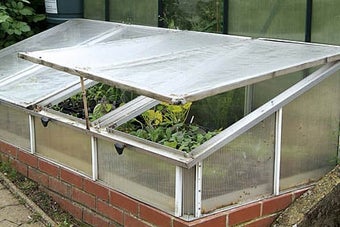
Quick facts
Top 5 annual climbers:
Lablab purpureus
Lathyrus odoratus
Ipomoea purpurea
Rhodochiton atrosanguineus - AGM
Thunbergia alata
Introduction
With a lengthy flowering period, often until the first frosts, you can choose from a vast range of annual climbers (and some climbers which are treated as ). They are easy to grow from seed or are increasingly available as plants in garden centres and by mail order.
Annual climbers are ideal for rambling and trailing over fences, trellis, arches and pergolas. They can be grown through more permanent host plants such as evergreen shrubs and perennial climbers. Always useful for summer containers on the patio, they can brighten the conservatory or greenhouse through the year.
For more information see;
The Garden magazine April 2010.
Seeds: the ultimate guide to growing successfully from seed by Jekka McVicar (Kyle Cathie in association with the RHS 2008, ISBN 9781856267830)
These are made available through the RHS Lindley Library.
Practical considerations
Many of the climbers recommended here take some time to get going. To avoid a disappointing show, sow seed early in the year (February) or, if suitable sowing conditions are not available, consider buying young plants by mail order or from garden centres instead.
Most annual climbers by tendrils and require suitable structures on which to climb. Consider attaching plastic netting or frames to fences, installing wires and using canes or pea sticks for support.
To improve shape and increase the number of flowering shoots, the tips of new shoots during the growing season. Cut back over-long stems in autumn and remove unwanted shoots whenever they appear. Train the plant to cover the area required which should, ideally, be situated in prolonged sunshine.
Consider the soil type and container compost when planting. Most annual climbers will thrive in the open ground in any fertile well-drained soil. Add organic matter such as manure before planting and fertiliser as recommended by the manufacturer if in doubt.
If using a container, loam-based such as John Innes No 2 is ideal as it holds much water and is easily re-wetted. Climbers act as wicks and can very quickly dry out in containers. When in growth, water freely and apply a balanced liquid fertilizer every two weeks.
Suitable plants
Quick to grow and flower from early sowing, choose annual climbers for foliage texture and colour as well as dazzling flower colour.
A number of climbers listed here are technically but due to being tender or prone to scruffy growth after year one, are usually grown as ; i.e. discarded at the end of the year and grown fresh from seed each spring. Those that fall into this group are indicated by a P for perennial below;
Cobaea scandens (cup and saucer vine) P: Large and distinctive greenish-white summer flowers turning inky purple with age and C. scandens f. alba AGM with creamy-white flowers until the first frosts. Height to 3-5m (10-15ft).
Eccremocarpus scaber (Chilean glory flower) P: Slender tendril climber with tubular flowers in shades of red, orange, pink and yellow, late spring to autumn and leaves composed of greyish-green leaflets. Reaches a height of 3m (10ft).
Ipomoea purpurea ‘Kniolas Black’ (common morning glory): Twining climber with trumpet-shaped flowers of purple-black and showing a cerise throat. It has bristly-hairy stems and lobed mid-green leaves. Height to 1.8-2.4m (6-8ft).
I. lobata ‘Jungle Queen’ (Spanish flag): Robust selection with vibrant crimson-orange tubular flower-spikes. Height 3m (10ft).
Lablab purpureus ‘Ruby Moon’ (Australian pea): Twining, with richly-coloured purple blooms, deep, shining-purple pods and purple-tinged foliage; this is perhaps amongst the most popular of annual climbers reaching a height and spread of 1.8-6m (6-20ft).
Lathyrus odoratus ‘Matucana’ (sweet pea): Climbing by tendrils with masses of highly fragrant magenta and purple-bicoloured flowers from early summer to autumn. Height to 3m (10ft).
L. belinensis: Excellent in containers as a dwarf bushy climber, with brilliant orange and yellow flowers. Height to 90-120cm (3-4ft).
Lophospermum scandens ‘Mystic Purple’ (twining snapdragon) P: Masses of deep-purple small snapdragon-like flowers and heart-shaped leaves. Height 3m (10ft).
Maurandya barclayana AGM: Free-flowering twining climber with summer flowers with white tubes and white, pink or deep purple lobes and lobed heart-shaped leaves. Height can be often in excess of 1.8m (6ft).
Phaseolus coccineus cultivars (scarlet runner bean): Delicate scarlet flowers and the bonus of edible pods provides a dense leafy screen.
Rhodochiton atrosanguineus (purple bell vine) AGM P: Slender-stemmed twining climber with a profusion of tubular black to reddish-purple flowers from summer to autumn and heart-shaped rich-green leaves. Height to 3m (10ft), sometimes more.
Thunbergia alata ‘African Sunset’ (black-eyed Susan) P: Twining climber displaying masses of brick-red to soft-cream flowers with a black centre and triangular mid-green leaves. An ideal climber for the border or containers using an obelisk or a frame for support. Height to 1.5-2.4m (5-8ft).
Tropaeolum majus Climbing mixed (nasturtium): Easy to grow children’s favourite, will happily scramble over any structure or shrubs in the border with distinctive long-spurred red, yellow or orange flowers and kidney-shaped bright- green leaves. Height to 3m (10ft).
T. peregrinum(canary creeper): Bright yellow-fringed flowers and pale-green dissected leaves. Height to 2.4m (8ft).
Links
Problems
Fungal diseases such as powdery mildews can be troublesome.
Watch out for scale insects on stems and under leaves and aphids on young shoots.
Sweet pea viruses can be a problem.





